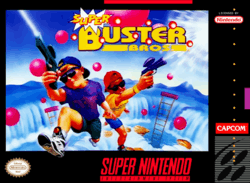Super Buster Bros.
| Super Buster Brothers | |
|---|---|
 Packaging for the Super NES version | |
| Developer(s) |
Mitchell Corporation (Arcade) Capcom (Super Famicom/NES) |
| Publisher(s) |
|
| Designer(s) |
Toshihiko Uda Futoshi Kuwahara |
| Composer(s) |
Tatsuya Nishimura Minae Fujii |
| Platform(s) | Arcade, Super NES |
| Release date(s) |
|
| Genre(s) | Shooter |
| Mode(s) | Single-player, multiplayer |
Super Buster Bros., also known as Super Pang (スーパーパン) outside of the USA, is a cooperative two-player shooting puzzle arcade video game developed by Mitchell and released in the United States in 1990 by Capcom.[1] It is the second game in the Pang series and was later ported to the Super Nintendo Entertainment System in 1992. It is also featured in the compilations Buster Bros. Collection for the original PlayStation and Capcom Puzzle World for PlayStation Portable.
Gameplay
The object of the game is to use your gun to pop bubbles that bounce around your screen. There are two different modes in this game: Panic Mode or Arcade Mode. When a player pops a bubble, it splits into two smaller bubbles. This happens repeatedly, but eventually, the bubbles get so small that they pop when shot. Occasionally, monsters will walk or fly on to the screen, these can be seen as a help or harm to the player. When the player touches a monster, they die, but monsters can pop bubbles. This is the next part of super pang with added stages. Although the arcade game (and the later PlayStation version included in Buster Bros. Collection) allow two players to play simultaneously, the Super NES version only has one player mode. There are several powerups that can be found throughout the game. These are found by either popping certain bubbles, shooting boxes, or shooting certain spots in the level that are not marked. The gun powerups cannot be used in conjunction with each other.
Panic Mode
In this mode, the player tries to last as long as he can with an endless rain of bubbles. The default weapon is the bubble shot and cannot be changed at any time. Every time a bubble is popped, a rainbow bar at the bottom is slowly filled. Filling the bar all the way causes the level number to rise, and the bar depletes back to zero. As more bubbles are popped, the remaining and incoming bubbles move faster. A 'Panic' music plays when there's a very large amount of bubbles on the screen, but the normal music returns once enough bubbles are popped.
There is also one special type of bubble that appears rarely. The bubble can appear at any random time, and has a clock image engraved. Whenever the bubble bounces, the engraving changes to a star, and when the bubble bounces again, the engraving changes back to a clock. Popping the bubble when the clock engraving is present causes all bubbles to stop movement completely for 9 seconds, while popping the bubble when the star engraving is present causes all bubbles to be popped and the game screen gets cleared, filling the rainbow bar with every pop made from the bubbles that are being destroyed.
Every few levels the background of the game screen changes. The Panic mode locations start with a backwards order from the locations of the Arcade Mode, but after a few location changes the backgrounds change without a set pattern, although they always change in the same order. After about level 60, the location changes to the Canada mountains and remains there for the remaining levels.
Panic mode is beaten when the player reaches level 99, fills the rainbow bar and destroys any remaining bubbles on the screen (after the bar is filled and level 99 is reached, no new bubbles appear). The ending of the game is also different in Panic mode than in Arcade Mode
Arcade Mode
In this mode, the player moves from level to level, travelling all around the world. The player starts in Japan in a single introductory level in this location. After this first stage, the player travels to many parts of Asia, Europe and the Americas. Every location has three stages in the same setting. One during the day, the evening and at night. The few exceptions include the introductory stage of Japan (including only the day stage), Venice (including only the evening and night stages), The Mayan Ruins and the Caribbean Sea (both including only the day and evening stages).
Each of the stages has a set layout, consisting of walls, destructible glass walls, invisible walls, ladders and ice. There's items such as candy and 1-ups that can change the outcome of the stage. In the SNES version, there are four difficulty levels in the Arcade mode: Easy, Normal, Hard and Expert. Each difficulty has their own stage layouts, some remaining the same, some varying slightly and some changed completely. The amount of continues and general speed of bubbles is also affected by the difficulty level chosen.
References
External links
- Super Buster Bros. at the Killer List of Videogames
- Super Pang at the Killer List of Videogames
- Super Buster Bros. at MobyGames